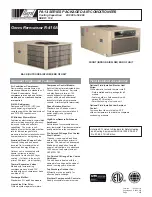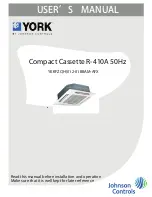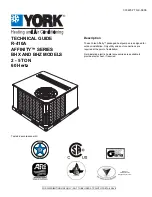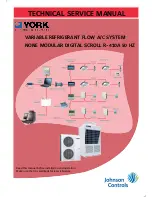
IM 926-3 • ROOFPAK APPLIED SYSTEMS 100 www.DaikinApplied.com
Check, Test, and Start Procedures
10.
Check the oil level in the compressor sightglass. If
low oil is observed, it is possible that liquid refrigerant
is returning to the compressor. Check the suction
superheat, see
Expansion Valve Superheat Adjustment
It should be between 10°F (5.5°C) and 13°F (7.2°C).
11.
Open switch S1. The compressor(s) should stop. Place
the unit into the “Fan Only” mode through the keypad
menu
System Summary \ System \ Ctrl Mode= Fan Only
.
12.
Check refrigerant circuit #2 by repeating steps 2 through
9, substituting circuit #2 nomenclature for circuit #1
nomenclature (S2, TD2, SV2, CCB2, compressor #2 and
#4).
13.
Verify that the condenser refrigerant subcooling at full
capacity is between 13°F and 20°F.
Expansion Valve Superheat Adjustment
It is very important that the expansion valve superheat setting
be adjusted to be between 10°F (-12°C) and 13°F (-11°C).
Insufficient superheat will cause liquid floodback to the
compressor which may result in slugging. Excessive superheat
will reduce system capacity and shorten compressor life.
Turn the adjustment stem clockwise to increase superheat.
Not exceeding one turn, adjust the stem and then observe the
superheat. Allow up to 30 minutes for the system to rebalance
at the final superheat setting.
On refrigeration circuits with multiple expansion valves, the
superheat adjustment should be approximately the same for all
valves in the circuit.
NOTE:
If low oil level is accompanied by heavy foaming
visible in the oil sightglass, it is possible that excess
liquid refrigerant is returning to the compressor
depending on the rotation of the crank shaft. Check
the suction superheat and adjust the expansion valve
for 10°F (–12°C) to 13°F (–11°C) of superheat. If
proper superheat is obtained, sightglass foaming is
not a concern.
For RCS/RFS applications in which the condensing section
is remote from the air handling section, consideration should
have been given to proper piping between the sections, as
this can affect the compressor oil level. Refer to the “ASHRAE
Handbooks” for more information on proper refrigeration piping
design and installation.
R-407C Superheat
Due to refrigerant glide, when measuring and/or adjusting TEV
superheat, it is important to use SATURATED VAPOR (Dew
Point) TABLES. Example: The Pressure/Temperature (P/T)
chart shows that the saturated vapor temperature, at the dew
point, of R-407C for 79 psig is approximately 51°F. If the actual
refrigerant temperature is 60°F, the superheat is 9°F.
Checking Superheat
Following are recommendations for checking superheat:
1. Close the unit section doors. Running the unit with
its doors open will affect expansion valve and system
operation considerably.
2. For units with one expansion valve per circuit, check the
pressure and temperature at the compressor suction
valve.
3. For units with multiple expansion valves per circuit,
check the pressure at the compressor, and check the
temperature at the suction header that is fed by the valve.
Содержание RoofPak RPS Series
Страница 71: ...Wiring Diagrams www DaikinApplied com 71 IM 926 3 ROOFPAK APPLIED SYSTEMS Figure 87 VFD Control SAF and RAF...
Страница 72: ...IM 926 3 ROOFPAK APPLIED SYSTEMS 72 www DaikinApplied com Wiring Diagrams Figure 88 VAV Control Inputs...
Страница 76: ...IM 926 3 ROOFPAK APPLIED SYSTEMS 76 www DaikinApplied com Wiring Diagrams Figure 90 Electric Heat Control...
Страница 129: ......
















































